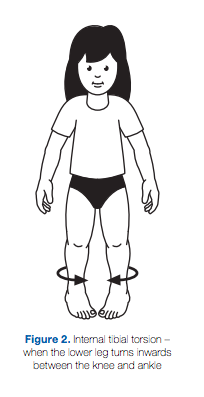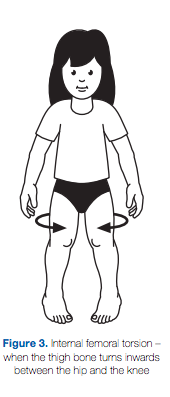When you’ve got foot pain, many people will try anything that promises to get rid…
The One Easy & Simple Solution For In-toeing: The Gait Plate
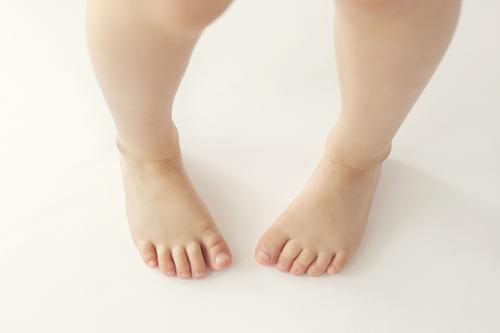 In-toeing (or pigeon-toeing) is a condition that affects both children and adults alike – though adult toeing is usually a result of childhood in-toeing not being treated! It looks like the feet are pointed inwards, like this:
In-toeing (or pigeon-toeing) is a condition that affects both children and adults alike – though adult toeing is usually a result of childhood in-toeing not being treated! It looks like the feet are pointed inwards, like this:
While on the outside it may just seem like a ‘funny walk’, the reality is that in-toeing:
- Causes tripping and falling over the knees
- Denotes a structural irregularity with the lower limbs
- Where in-toeing is caused by the internal rotation of the tibia or the femur, this rotation may increase the likelihood of other lower limb problems and pains
What causes in-toeing?
If you want to get specific about the causes of in-toeing, there are 3 distinct causes:
- Metatarsus Adductus is the first cause and is where the forefoot is curved inwards relative to the rearfoot. This may be described as a ‘banana-shaped’ foot and is thought to be a result of the position of the baby in the womb, so is present at birth.
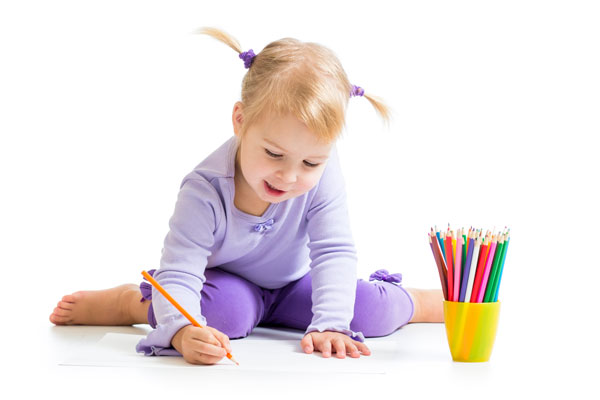 Tibial Torsion is the second cause and describes the inward rotation of the tibia – the shin bone. Because the tibia is turned inwards, so is the ankle and foot, resulting in in-toeing. Here, correcting the position of the shin bone will correct the in-toeing.
Tibial Torsion is the second cause and describes the inward rotation of the tibia – the shin bone. Because the tibia is turned inwards, so is the ankle and foot, resulting in in-toeing. Here, correcting the position of the shin bone will correct the in-toeing.
- Lastly, Femoral Torsion describes the inward rotation of the femur – the thigh bone. The rotated position of the thigh bone also rotates the shin bone and the foot, causing in-toeing. This is one of the reasons that children are discouraged from sitting in the ‘W’ position – because it rotates the thighs inwards (see to the right).
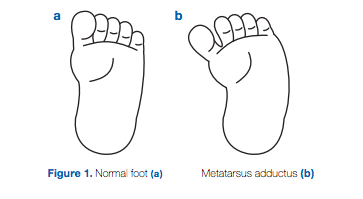
The Solution
 The solution comes in the form of a specific orthotic device called a Gait Plate. The gait plate is designed following the examination, assessment and measurement of the feet, and works by encouraging the outward rotation of the feet with every step. This device is placed into that shoes that are worn on a daily basis and like a regular orthotic, can be moved from shoe to shoe. They are no less bulky than a regular orthotic either – it’s their angled design matched below specific bones that encourage this movement. Here’s an example of a gait plate made for one of our school-aged patients below, as well as a template of the shape beneath the cushioned cover.
The solution comes in the form of a specific orthotic device called a Gait Plate. The gait plate is designed following the examination, assessment and measurement of the feet, and works by encouraging the outward rotation of the feet with every step. This device is placed into that shoes that are worn on a daily basis and like a regular orthotic, can be moved from shoe to shoe. They are no less bulky than a regular orthotic either – it’s their angled design matched below specific bones that encourage this movement. Here’s an example of a gait plate made for one of our school-aged patients below, as well as a template of the shape beneath the cushioned cover.
Delivering Great Results
Here at Masterton Foot Clinic, we pair a custom-made gait plate device with specific stretching and strengthening exercises based on your cause and what will get your feet back to their straight selves as effectively as possible.
We monitor you and stay with you every step of the way to make sure we’re both seeing the results we want over an optimal timeframe. We use photography and video to track the changes over time – which is always fantastic to look back on and see how far you’ve come!
If you’re worried about in-toeing for yourself or anyone in your family, give us a call on 06 370 4057 or book online here.
FAQS
Does in-toeing correct itself?
In young, growing children, in-toeing can be a normal part of the growth and development process and can correct itself as your child continues to grow. The older a person gets, particularly into the late primary school years, highschool years and as an adult, the less likely that in-toeing is to resolve itself.
Can in-toeing cause back or hip pain?
In-toeing itself is not a typical cause of back or hip pain, but inwards rotation of the leg may in some cases be associated with other causes of pain or problems like hip dysplasia. If you or your child is experiencing other pains alongside in-toeing, it’s always best to have an appointment with your podiatrist.
Can in-toeing in adults be corrected?
This varies on a case-by-case basis and depends on other factors like your flexibility and range of motion, but we may be able to use devices like gait plates to help encourage the foot to straighten.
Is in-toeing normal?
In the early years, yes, in-toeing can be a normal part of growth and development. What we don’t consider normal is getting pains either directly from your in-toeing, or from injuries caused by your in-toeing like from regular tripping and falling.
What does it mean if in-toeing is only affecting one foot?
This isn’t something to worry about – in-toeing may affect one or both feet, and either way the in-toeing can either naturally resolve with age or we can help treat it using gait plates and specific exercises.
Is in-toeing treatment covered by health insurance?
This depends entirely on your insurance policy and your level of cover. If your policy covers your child for podiatry, then it is likely your insurer will be able to assist. Please contact your insurer directly to confirm.
Is in-toeing treatment covered by ACC?
Generally, no. This is because in-toeing isn’t an accidental injury, so typically doesn’t fall under the criteria covered by ACC.

